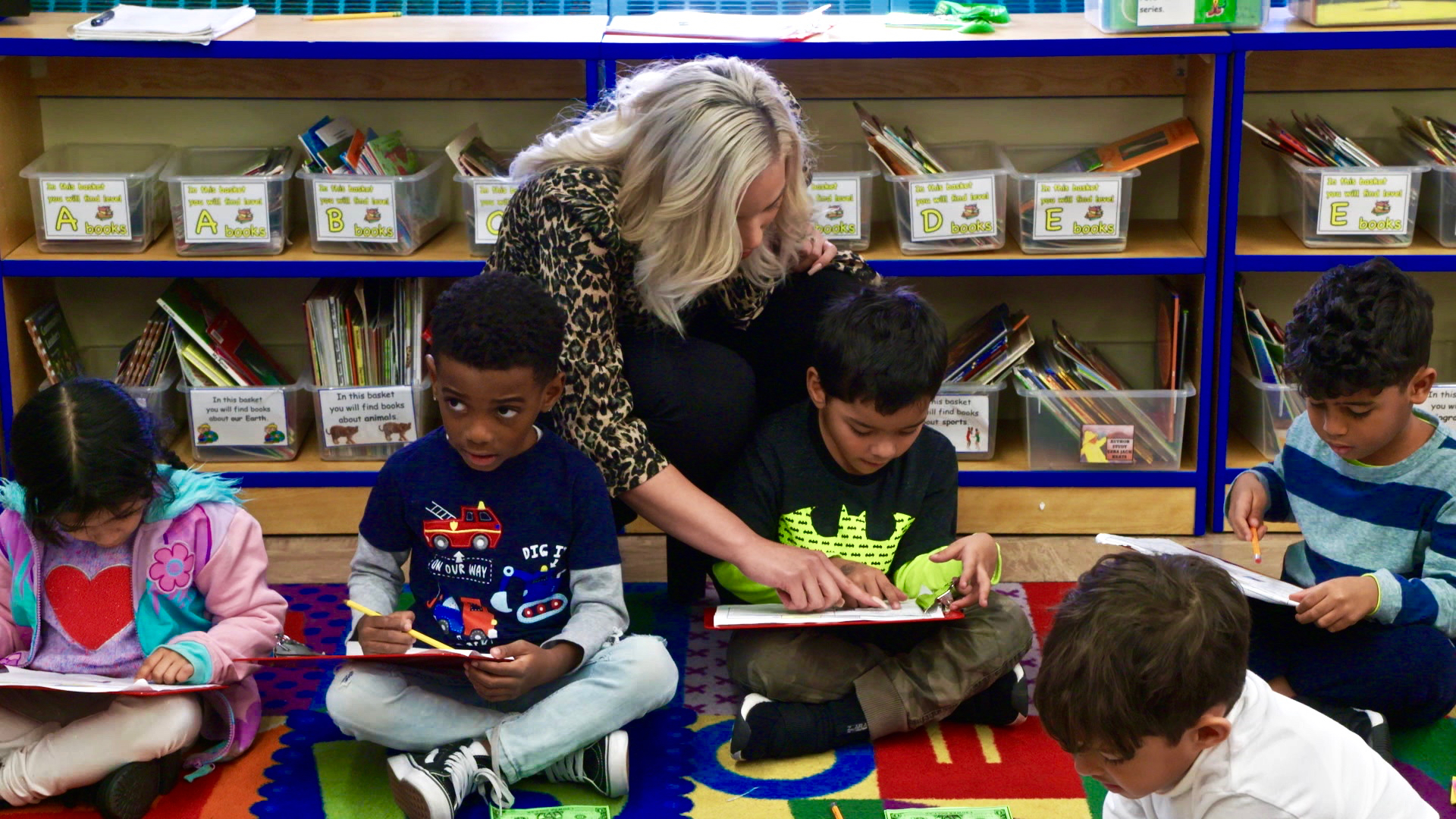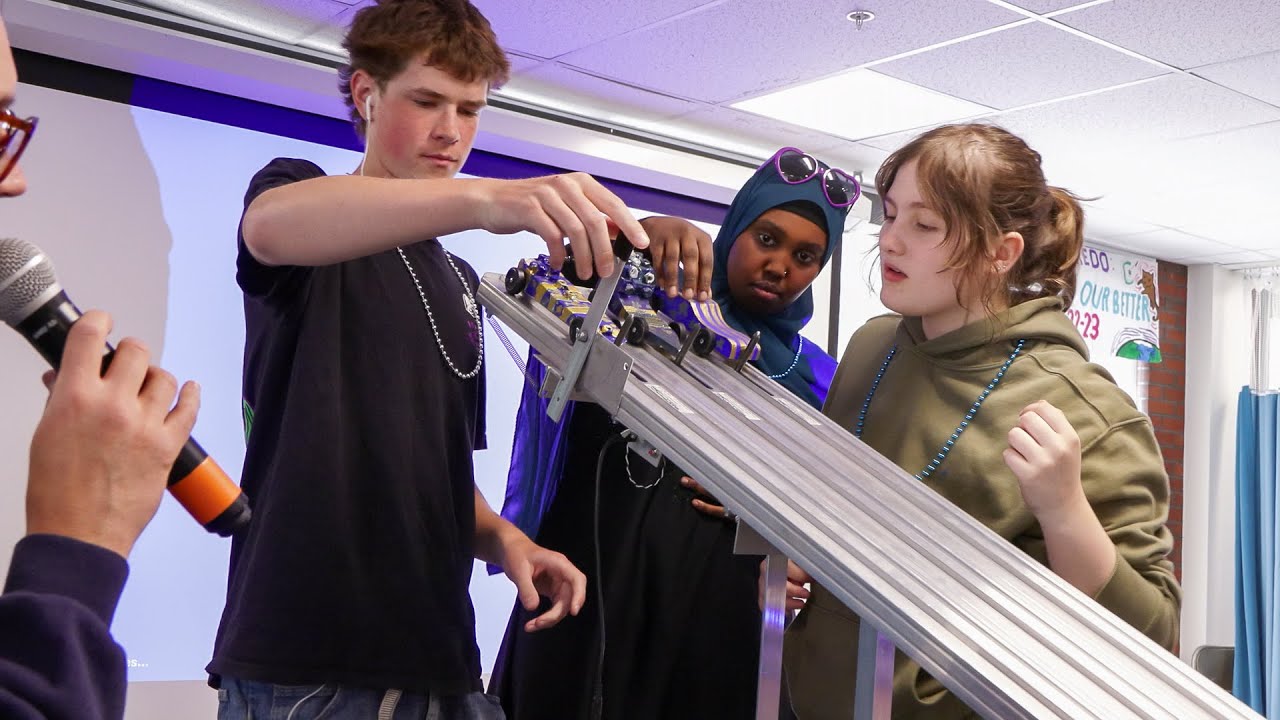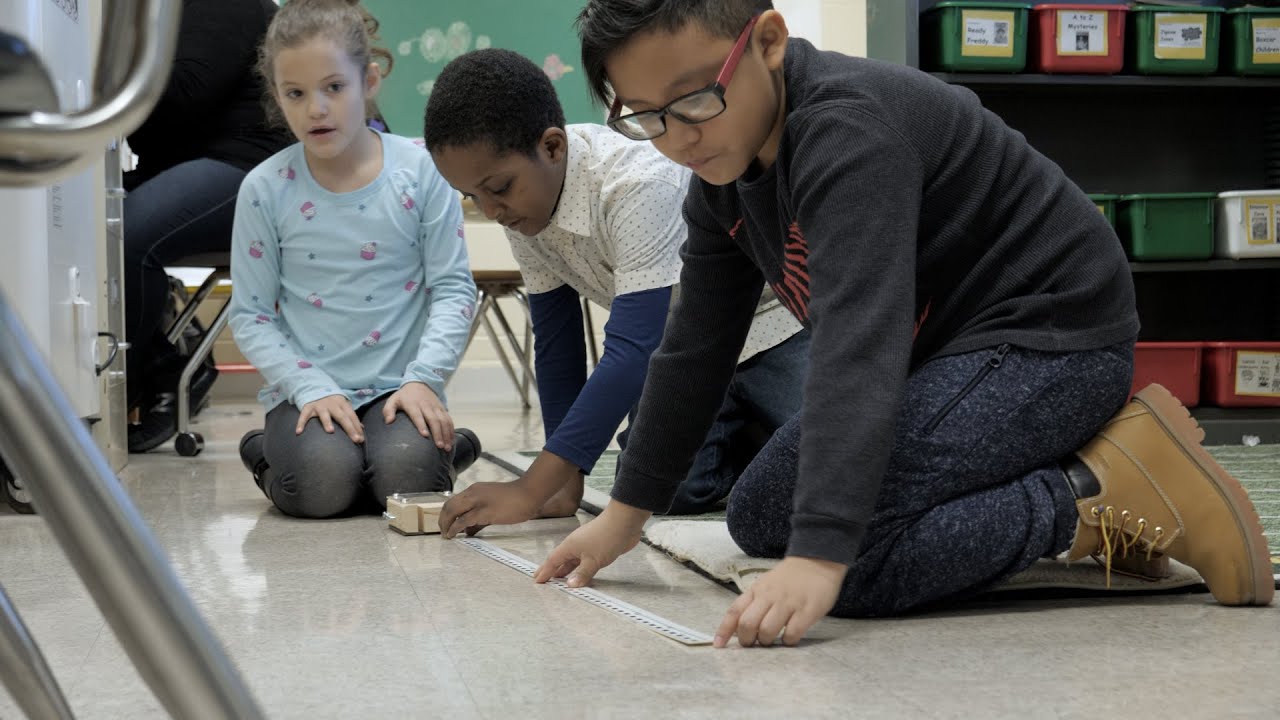[ad_1]
4 second-grade boys at Concourse Village Elementary College throughout the Bronx are lying on a rug, kicking their legs throughout the air as gentle saxophone music performs over a classroom speaker. Nevertheless their coach, Mr. Lozada, doesn’t inform them to perk up or stop wiggling: They’ll wiggle all they want, as long as they think about the day’s math lesson on skip counting.
In a single different part of the room, a woman strikes to the whiteboard to place in writing up her reply to a math disadvantage and numerous different others work on iPads, whereas a co-teacher and a pupil coach movement into throughout the room to help.
At first look, the fluid classroom building contrasts with a couple of of the usual data about what it takes to be taught at a high-poverty public college ranked better than virtually 96 % of elementary schools in New York Metropolis—outcomes similar to these for the top-performing “no excuses” structure schools the place strict pointers and regimens are credited with success.
In its place, at Concourse Village, a mixture of extreme expectations for faculty college students, a flat reporting building that places a premium on coach empowerment, and an trendy literacy-first methodology in all matters are serving to the 361 faculty college students excel. Eighty-eight % of students handed English and math state checks in 2018, better than 40 elements better than the citywide frequent, and in 2018, the school was awarded a Blue Ribbon for Excellence from the U.S. Division of Coaching.
video
Part of the school’s effectiveness stems from a notion that every one faculty college students might be taught when given entry to every high-quality instructing practices and a supportive and guarded learning environment, says Principal Alexa Sorden, a former coach whose kids moreover attend the school. Every morning, lecturers greet kids with hugs and handshakes as they arrive in class, scan for any indicators of trouble, and intervene accordingly.
“We’re located throughout the poorest congressional district throughout the nation. For a really very long time that was used as a result of the excuse as to why success wasn’t occurring,” said Sorden of the students, 15 % of whom are homeless. “As a frontrunner of a college, I don’t have conversations about whether or not or not a pupil has an IEP or lives in a shelter—I don’t take into account these points stop you.”
Getting on the Equivalent Internet web page
The varsity wasn’t always a success story.
In 2013, Sorden reopened the elementary college after its predecessor was shut down for poor effectivity and disrepair.
“Beforehand, there wasn’t any consistency,” says Sorden, who grew up in shut by Washington Heights in a low-income household. “I needed the whole thing to be aligned—from the furnishings to the language—so the children may need a approach of predictability and actually really feel protected.”
College Snapshot
Enrollment
361 | Public, Metropolis
Per Pupil Expenditures
Free / Decreased Lunch
96%
DEMOGRAPHICS:
66% Hispanic
33% Black
1% Totally different
Information is from the 2018-19 tutorial 12 months
When the equivalent first and second graders returned for Sorden’s first fall on campus, that they had been greeted by a freshly painted setting up, new modular furnishings, and new lecturers. Part of the transformation included a shift in administration that gave lecturers further autonomy. A flat administration building—Sorden is the one administrator on campus—encourages Concourse Village employees to be taught from each other and perception that they know what’s best for his or her faculty college students.
Using a fastidiously choreographed course of generally known as intervisitation, Sorden pairs off lecturers with complementary strengths and weaknesses. For six weeks at a time, these pairs, or “progress companions,” go to at least one one other’s lecture rooms as quickly as each week for quarter-hour to take a look at. Afterward, they meet to provide options within the equivalent format that they educate kids: TAG (inform one factor you need, ask a question, and give a suggestion).
video
When Lizzette Nunez, a fourth-grade English and social analysis coach, received right here to indicate at Concourse Village she seen that there “was a distinction throughout the native climate.”
“It wasn’t ‘Shut your door.’ It was ‘We’re a employees; we will present assist to; we will work collectively. If I’ve a best comply with, I will share it with you’,” she said.
A Literacy-First Methodology
To find out environment friendly practices throughout the college, Sorden drew on her private 9 years of experience as a classroom coach and literacy coach, when she developed an methodology generally known as Collaborative Learning, a mixture of choral learning and shut learning.
Inside the model, faculty college students be taught elements of newest, troublesome grade-level and above-grade-level texts aloud collectively each single day to boost vocabulary and improve learning proficiency. Then, they reply questions in small groups following the MACAS methodology (most vital idea, annotation, comprehension, creator’s purpose, and summary) to demystify the often-opaque course of of analysis in a shared, protected home sooner than trying it on their very personal.
video
The varsity moreover emphasizes that literacy experience must be taught in all disciplines. Every class, from paintings to math, focuses on shut learning and reflective writing to assemble faculty college students’ essential inquisitive about texts.
“I was prepared on account of the lecturers taught me correctly,” says Kianna Beato, a CVES graduate and current seventh-grade pupil, who cites methods paying homage to annotation and rereading in every math and English as boosting her confidence and expertise. “I knew there was nothing to be afraid of in a particular college.”
In Yasmin Al-Hanfoosh’s class, Mozart is collaborating in as third graders work in groups of six on shut learning of scientific textual content material. Al-Hanfoosh directs faculty college students to check out phrases which is likely to be throughout the instant—“What are magnets used for?”—that are moreover throughout the textual content material to look out the precept idea throughout the passage. After they finish, they go to a station and comply with discovering the precept idea on their very personal in a model new article.
In math classes, all faculty college students observe a set of 5 regular steps as soon as they treatment math phrase points: annotate the problem; take into account a plan to resolve it; use a method to resolve it; describe the best way it was solved using labels and math language; and ultimately, make connections by determining patterns and pointers.
“It’s important on account of their learning experience are going to boost,” explains Blair Pacheco, a math and science coach. “They’re honing in on specific phrases, so it’s going to help them get the gist and really understand the content material materials of what they’re learning.”
A Custom of Extreme Expectations
The think about literacy has even extended to rising a deeper understanding and appreciation for paintings.
In Courtney Watson’s second-grade paintings class, faculty college students talked about refined concepts like how color conveys mood in artist Romare Bearden’s The Block and Edward Hopper’s Railroad Embankment, and the best way mood connects to understanding choices of rural, metropolis, and suburban communities. Afterward, they utilized the themes to their very personal objects of artwork work.
“A textual content material can usually be very intimidating, significantly for a struggling reader or an English language learner,” said Watson, referencing the scholar demographics. “Art work is a standard language—every child can be taught a piece of paintings.”
video
This interdisciplinary methodology has pushed many Concourse Village faculty college students above grade stage in learning and math proficiency, along with faculty college students who started on the school understanding little to no English. Notably, English language learners and faculty college students with disabilities, who amount roughly 1 / 4 of the scholar inhabitants, score better than frequent education faculty college students on every math and English language arts state checks.
“We’re a bunch—that’s an actual assertion,” says second-grade coach Richard Lozada, who grew up near the school. “I’ve help; I can go to anyone. It’s making people actually really feel very cozy to ask what’s required and be taught from each other.”
[ad_2]
Provide hyperlink



